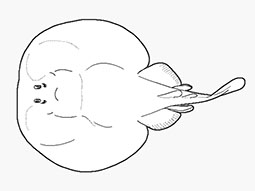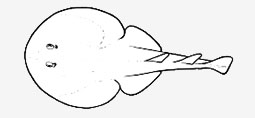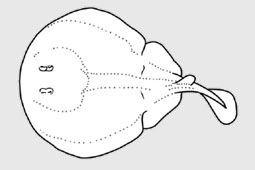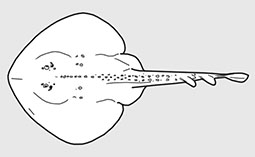Distribution: Australia. Short description: Head equipped with electric organs, developed from branchial muscles; eyes small; disc emarginate anteriorly; jaws extremely slender; no labial cartilage; rostrum reduced; tail very small; 2 dorsal and caudal fin very small. Skin soft and loose. Large specimens can give a severe jolt, normally used to stun small fishes on which they feed. The young hatch inside the uterus and are born fully developed. As a subfamily in Ref. 58010. As a family in Compagno 2005 and CofF.
Distribution: Atlantic, Indian and Pacific Oceans. Short description: Disc rounded anteriorly; head equipped with electric organs, developed from branchial muscles; eyes small; jaws stout, long and strongly protractile; strong labial cartilages; rostrum broad; deep groove around mouth; usually 2 dorsal fin; caudal fin well developed . Subfamily Narkinae elevated to family rank. Comname: Numbfish (Ref. 3929).
Distribution: Indo-West Pacific. Short description: Disc rounded anteriorly; head equipped with electric organs, developed from branchial muscles; eyes small; jaws stout, short and weakly protractile; strong labial cartilages; rostrum narrow; shallow groove around mouth; usually a single dorsal fin. As a subfamily in Narcinidae in Ref. 58010. As a family in Compagon (2005) and CofF. Distribution: Atlantic, Indian and Pacific Oceans.
Distribution: Northwest and Eastern Central Pacific; cool-temperate to tropical continental areas; demersal in shallow water, on soft substrates from nearshore to at least 137 m depth, none ventures into freshwater. Fanrays are small to medium-sized (30-90 cm TL for adults) with firm body, large, flattened subcircular to shovel-shaped disc and has an rlongate tapering tail; pectoral fin rays which form the disc, extnd forward to snout tip and beyond pelvic-fin origins; nostrils close to the mouth, eyes narrowly separated and well removed from disc margin; short anterior nasal flaps not joined together to forma broad, flap-like nasal curtain; no dermal folds on spiracles; upper surface with sharp thorns or enlarged denticles on head, shoulders and in row along mid-line of the body; 2similar dorsal fins close together on tail and located well behind pelvic fins; caudal fin elongate and without a distinct lower lobe; slender tail, abruptly narrower than trunk, well-developed lateral folds and without a stinging spine; colour plain or with transverse stripes, without pectoral ocelli; ventral surface usually uniformly white. Biology: ovoviviparous; life history mostly little known; feeds mainly on small marine invertebrates, including crustaceans, molluscs and worms. Use: eaten fresh or salt-dried, caught mainly as bycatch of net fisheries. Genera: Platyrhina, Platyrhinoidis.

Torpedinidae - (Electric rays)
Distribution: Atlantic, Indian and Pacific Oceans. Short description: Head equipped with electric organs, developed from branchial muscles; eyes small; disc truncate anteriorly; jaws extremely slender; no labial cartilage; rostrum reduced; tail well developed; 2 dorsal and caudal fins well developed. Skin soft and loose. Large specimens can give a severe jolt, normally used to stun small fishes on which they feed. The young hatch inside the uterus and are born fully developed. Subfamily Hypninae elevated to family rank.
Note: Families with unknown counts of dorsal or anal spines are also included



